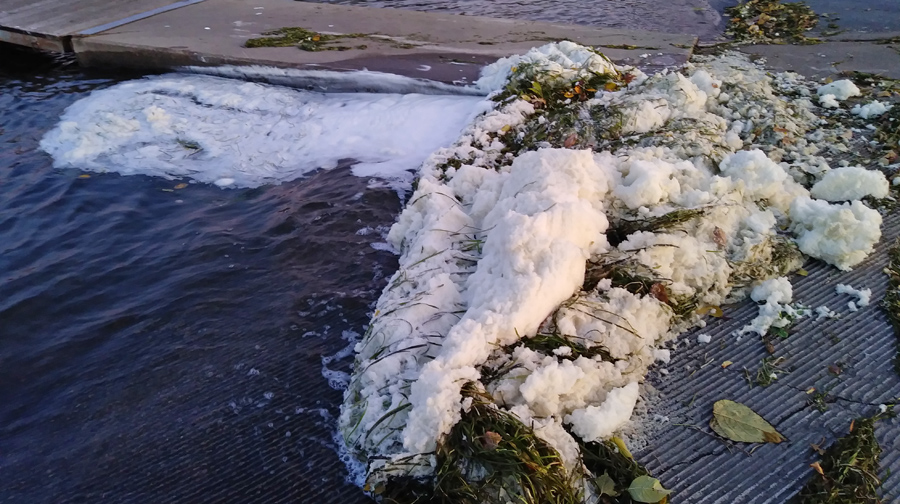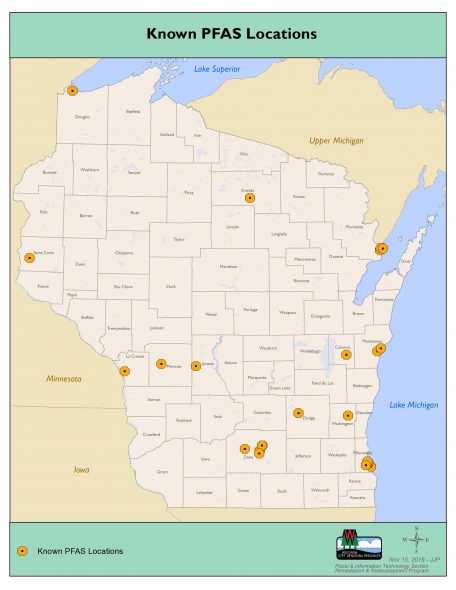How State Reopening is Affecting PFAS Testing
DNR now navigating various local orders.

Foam present in Starkweather Creek in October shows elevated levels of PFOS and PFOA. Photo courtesy of the DNR.
The decision by the Wisconsin Supreme Court to side with Republican state legislators and throw out the Safer at Home order not only created a scramble as local governments make their own rules, it has also affected certain operations in the Department of Natural Resources (DNR).

This graphic, supplied by the Wisconsin DNR, shows identified locations of PFAS concentrations around the state as of November 2015. Image courtesy of Wisconsin DNR.
As the realities of the pandemic began setting in, the department sought to continue its efforts to identify and clean up land and waterways contaminated by PFAS (per- and polyfluoroalkyl substances). Not long before the Supreme Court decision, the DNR began evaluating a request by Johnson Controls to halt well-water sampling until the statewide public health emergency subsided. Throwing out Safer at Home, however, has affected that evaluation process.
PFAS, along with PFOA (Perfluorooctanoate), make up an expansive family of man-made chemicals dating back decades. The compounds repel water and other substances when sprayed as a coating onto a surface, and do not break down in the natural environment. They have been used in a variety of products from non-stick Teflon pans to fast food wrappers, clothing and firefighting foam. Over time the compounds have also been linked to disease in both humans and other animals, from cancers to birth defects.
Sometimes referred to as “forever chemicals,” these man-made products move from one medium to another, and do not break down once they enter the body. Regulating them, and cleaning up contamination sites, became a growing priority of the state Legislature before COVID-19 arrived in the U.S.
Wisconsin’s Department of Health Services has stated that PFAS levels in water exceeding 20 ppt (parts per trillion) are not safe. In an April Zoom call update Christine Haag, DNR remediation and redevelopment program director, described PFAS research as a “still very emerging as a science.”
Numerous contamination sites have been detected throughout Wisconsin. Some are decades-old landfills, others are private wells or lakes and streams which the state has only recently discovered are contaminated.
Most recently in Milwaukee, PFAS was detected in the Estuary Area of Concern. About 13 locations in the Milwaukee, Menomonee and Kinnickinnic Rivers, a spot in Lake Michigan, and along the inner and outer harbors have been shown to have not just PFAS, but also lesser known PFHxS (Perflurohexanesulfonate) and others still.
Cleaning up these areas is a joint effort between the DNR and the companies which were responsible for the specific site. In Wisconsin, a main subject of PFAS cleanups and well-testing has been Johnson Controls, and it’s subsidiary Tyco Fire Products. Even as recently as mid-April, the company had been ordered by the DNR to provide emergency drinking water to three homeowners in the Marineette and Peshtigo areas. These regions became the faces of Wisconsin’s battle with PFAS contamination. These three wells tested at 1,157 ppt for PFAS. Shortly afterward, the DNR would hold the Zoom call where Haag would announce the request to pause well sampling by Johnson Controls.
“The DNR’s Remediation and Redevelopment program has over 3,000 open cleanup sites across the state,” a DNR spokesperson told Wisconsin Examiner. “Activities at those sites were affected by the safer at home orders because environmental consulting activities were not explicitly identified as essential.”
Johnson Controls issued its request when Safer at Home was in effect. Now, the DNR must juggle the still developing patchwork of local orders, or lack thereof. “With the Wisconsin Supreme Court ruling, the DNR is evaluating the impact it has on our regulated communities,” a DNR spokesperson said, adding that local and county Safer at Home orders might affect the ability to mobilize environmental consultants to resume sampling and other efforts at sites throughout the state.
How this will affect the ability for water to be tested and emergency supplies to be issued by residents continues to unfold.
Reprinted with permission of Wisconsin Examiner.
More about the PFAS Problem
- Bipartisan Push to Tell Counties Faster When Water Tests Fail - Henry Redman - Dec 19th, 2025
- MKE County: County Seeks to Sue PFAS Producers, Oil Companies - Graham Kilmer - Dec 10th, 2025
- Wisconsin Reviewing EPA-Approved Pesticides For PFAS - Danielle Kaeding - Dec 9th, 2025
- State Nears Settlement with Johnson Controls/Tyco Over PFAS Spills - Danielle Kaeding - Dec 4th, 2025
- Senate Bill Promotes Soybean-Based Firefighting Foam to Replace PFAS - Danielle Kaeding - Dec 2nd, 2025
- Test Results Show High PFAS Levels in Wisconsin’s Landfill Runoff - Danielle Kaeding - Dec 2nd, 2025
- Wisconsin Communities Get $282 Million for Drinking Water Projects - Danielle Kaeding - Nov 19th, 2025
- Gov. Evers, DNR Announce $282 Million to Improve Drinking Water Quality for Wisconsinites in 74 Municipalities - Gov. Tony Evers - Nov 18th, 2025
- Cleanup of PFAS Could Cost Wisconsin Billions - Danielle Kaeding - Nov 13th, 2025
- Cleanup PFAS Without Penalizing Innocent Landowners - Wisconsin Manufacturers & Commerce - Nov 4th, 2025
Read more about PFAS Problem here



















